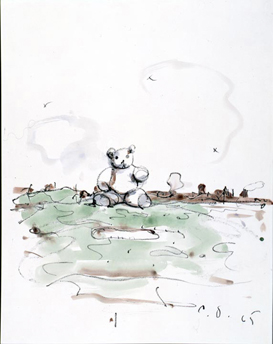
Monuments
Proposed Colossal Monument for Central Park North, N.Y.C. – Teddy Bear, 1965
Wax crayon and watercolor on paper
60.6 x 47.9 cm
Whitney Museum of American Art, New York Gift of the American Contemporary Art Foundation, Inc., Leonard A. Lauder, President
© Claes Oldenburg
“To make monuments in a new city is to use that city as a studio.” —Claes Oldenburg (1)
According to Oldenburg, the idea for his series of monuments came to him as he saw the Manhattan skyline appear before him during a taxi ride. “How nice it would be to have a large rabbit about the size of a skyscraper in Midtown,” he recalled thinking. “It would cheer people up seeing its ears from the suburbs.” (2) His watercolor of a giant teddy bear in Central Park, Proposed Colossal Monument for Central Park North, N.Y.C.: Teddy Bear (1965), gave concrete form to this kind of surreal vision.
Just as the city streets had transformed his studio in the project The Street, his studio would now transform the city. “To make monuments in a new city is to use that city as a studio,” he said, and in the beginning, New York was a special city: “New York was my favorite ‘room,’ my main plaything. I made toys for it, my city of cities.” (3)
He called these new works “monuments,” but they did not technically fit the definition. They did not fulfill a commemorative function. “It was a familiar word to signify something very large,” he said. “Later when I looked up the definition, I realized that ‘monument’ meant a memorial of some kind. At the beginning, I didn’t think of it that way.” (4) Unlike monuments, the works are not historical or political, at least on the surface, but rather function as satires of the banality and absurdity of American life. One inspiration for the works was the Macy’s Thanksgiving Day Parade; with its enormous balloons of popular American cartoon characters that float across the skyline, the parade represented the absurd, commercial aspects of American national identity. (5)
Oldenburg’s idea for the drawing Late Submission to the Chicago Tribune Architectural Competition of 1922: Clothespin (Version One) (1967) came to him while on a flight into Chicago. He was carrying a clothespin that he had been using to attach parts of cloth sculptures together in his studio. (6) When he held the clothespin up against the view of the Chicago skyscrapers from his window, he says he perceived a “certain Gothic character” to its shape and visualized it as a substitute for the Chicago Tribune Tower on Michigan Avenue. (7) The drawing’s title makes it sound as if the drawing was a recently discovered entry to the famous 1922 competition to design the Tribune Tower. At the time, the competition elicited many proposals that fell somewhere between architecture and sculpture.
Oldenburg’s drawing called for the insides of the building’s “legs” to be covered in blue glass and the ends of the clothespin’s “springs” to function as glassed-in restaurants. The passages through the building would produce a variety of sounds made by wind passing through. (8) In 1976, Oldenburg saw his vision of a clothespin monument realized in downtown Philadelphia outside of Centre Square, where the forty-five-foot tall, Cor-ten and stainless steel Clothespin went on display. (9)
1. Hochdörfer, Achim, and Barbara Schröder, eds, Claes Oldenburg: The Sixties (Munich: Delmonico Books, 2012), p. 182.
2.Jörg Wolfert, Claes Oldenburg: The Sixties exhibition brochure, translated by Cynthia Hall (Vienna: Museum Moderner Kunst Stiftung Ludwig Wien, 2012),p. 14.
3. Hochdörfer and Schröder, Claes Oldenburg, p. 182.
4. Ibid.
5. Jörg Wolfert, Claes Oldenburg: The Sixties exhibition brochure, p. 14
6. Claes Oldenburg and Coosje van Bruggen, Large-Scale Projects (New York: The Monacelli Press, 1994), p. 234.
7. Ibid.
8. Ibid., p. 233.
9. Ibid., p. 235.
Preguntas
Look together at the drawing Late Submission to the Chicago Tribune Architectural competition of 1922: Clothespin (Version One) (1967). What do students notice? They may be able to identify the object as a clothespin, but ask them to elaborate. From what perspective do they see the clothespin? What is in the background?
What do they notice about the form of a clothespin? Does it remind them of anything? How does Claes Oldenburg give the drawing a sense of scale?
The clothespin in this drawing was intended to be seen as a building in a city. Compare this building design to that of a skyscraper. Ask students what it would be like to move through this building. Oldenburg imagined that the “springs” of the clothespin would act as a restaurant and the “holes” would act as passages that produce sounds from the wind. Do students think this would be a good design for a building? Why or why not?
Look at the title of the drawing together. Why do they think he chose this title? Explain that Oldenburg imagined this drawing was a submission to a famous contest in 1922, in which the winner would get to design the Chicago Tribune building. What do they think the jurors for the contest would have thought of his submission? Compare it to the building that was actually built in 1922.
Examine the background of the drawing. The detail in the top left depicts the mosque and minaret on top of the skyscraper once known as Medinah Club (now the Intercontinental Hotel) north of the Tribune building. Why do students think Oldenburg chose to include this detail, but left out many others?
Oldenburg is very interested in form and what different forms remind him of, regardless of scale. He compared the clothespin to Gothic-style skyscrapers. When the clothespin sculpture was eventually built in Philadelphia, it was likened to Constantin Brancusi’s (1876–1957) The Kiss (1916), which was on view in the Philadelphia Museum of Art. (1) What do students think of this comparison? Would they liken the drawing to anything else?
1. Ibid., p. 235.
